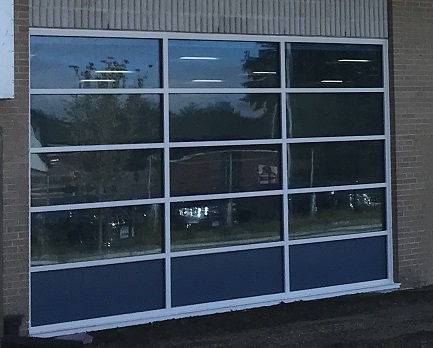The building envelope can be thought of as a bubble that creates a physical barrier between the interior and exterior. This bubble is comprised of the walls, windows, roof, and foundation all coming together as one system. A poorly constructed envelope allows unwanted air or moisture movement (in or out of the building) that results in uncomfortable occupied spaces and increased energy costs. A well-constructed envelope allows the air entering and leaving the building to be carefully controlled through the HVAC systems rather than lost through holes in the envelope. Commissioning envelope systems presents a unique challenge because it’s not feasible to inspect every application of air-vapor barrier or to review every window installation for compliance with project details. Providing a complete and thorough review of all aspects of the building envelope would require several months of daily observations, something that is well beyond the budget and scope of most projects. Envelope testing provides a means for establishing quality through representative sampling that allows the commissioning agent to assess to overall installation quality.
Two critical aspects of the building envelope are the air-vapor barrier (AVB) and fenestration products. Typically, an AVB is applied to exterior walls as a sheet or sprayed as a liquid to achieve a specified thickness. Fenestration can be described as a rough opening in a wall where a window will be installed. Further, the windows can be installed in the wall as standalone units or they can be the wall themselves (an exterior wall comprised of windows is called a curtain wall). Two of the most common window systems used in commercial buildings are:
- Storefront (pictured left) – non-load bearing system that is less than 10’ in height (one floor)
- Curtain Wall (pictured right) – non-load bearing exterior wall cladding that is more than 10’ in height (typically spanning multiple floors)


The most common quality control assessment for AVB is adhesion strength testing of the AVB according to the American Society of Testing and Materials (ASTM) standard D 4541. This type of testing, typically called pull testing or adhesion testing, is used to measure how well the AVB has adhered to the substrate, which is usually concrete blocks or gypsum board.
The quality of window installations can be assessed based on several ASTM and American Architectural Manufacturers Association (AAMA) standards, outlined in the table below, based on the type of window system. The table below provides a breakdown of tests by application and governing body.
| Governing Body | Name | Description |
| ASTM | D 4541 | Pull-Off Strength of Coatings Using Portable Adhesion Testers (Used for Sheet and Fluid Applied AVB) |
| ASTM | E 783 | Field Measurement of Air Leakage Through Installed Exterior Windows and Doors |
| ASTM | E 1105 | Field Determination of Water Penetration of Installed Exterior Windows, Skylights, Doors, and Curtain Walls |
| AAMA | 501.2 | Quality Assurance and Diagnostic Water Leakage Field Check of Installed Storefronts, Curtain Walls, and Sloped Glazing Systems |
| AAMA | 502 | Voluntary Specification for Field Testing on Newly Installed Fenestration Products |
| AAMA | 503 | Voluntary Specification for Field Testing of Newly Installed Storefronts, Curtain Walls, and Sloped Glazing Systems |
The first time that I witnessed building envelope testing, I’ll admit that the full utility of the test wasn’t clear to me. With experience, however, the benefit of such testing has become increasingly apparent. In some cases, the tests are pursued as a due diligence measure and the results show that no further testing is necessary. In other cases, these tests are the only reliable method for identifying and resolving installation issues.
During a round of testing at one of our projects, multiple leaks were found in the initial sample selection of windows. These particular windows were custom-made for the project and assembled on site, so there were no known errors or previous experience to help identify problems. If the windows had been mass-produced and already installed on other projects, then it’s likely that any inherent defects would have been discovered previous to the issues encountered on this project. A second round of testing found even more leaks. The owner, at this point, was looking at the possibility of more than 200 windows that leak in a brand-new building. Replacing them would not only be massively expensive, but it would also delay the project by several months. The only viable path forward was to continue spray testing according to the appropriate standard and use each test as a means of determining common failure points. From here, the window manufacturer and installing contractor were able to make corrections to all the installed windows, which were then retested. The subsequent retesting revealed positive results. Prior to this point, there had been discussion of testing every single window that had been installed. But now, after several rounds of successful retests on windows that had previously failed, the issue was resolved.
There are, however, situations that make spray testing inadvisable because it may cause issues without providing any useful information. One such situation presented itself recently during a design phase kickoff meeting. The project was a renovation of an existing building where all the windows were being replaced with more efficient ones, but the existing exterior walls and fenestrations were to remain as is. When windows are spray tested, the fenestration and wall around the window is part of the test as well because it all acts as one system (the wall and window work as one to create a weather resistant barrier). Because the fenestration and walls were existing and of significantly older construction, they are less “tight” than those built with modern methods. In this case, performing spray testing would most likely result in leaks of the existing fenestration and wall components but not the window itself, yet would be considered a failure, albeit a “false” one. Additionally, the leaks may allow water to enter the wall cavity where it would remain and possibly cause damage and deterioration issues. After this was discussed with the design team, it was determined that spray testing would not be specified as part of this project. Instead, a very thorough examination of the window installation was agreed upon as a reasonable measure of quality assurance.
By testing envelope components early, and according to performance based standards, many specific installation and component problems that would not be visually detected can be identified and corrected before they become systemic. However, the applicability of such tests should be carefully considered for situations where the fenestration product is the newest part of the whole system. Otherwise, false test failures may result, and water may be introduced to the building with undesirable effects. Envelope testing is a great way to identify issues early on or to simply provide peace of mind that the building bubble will be tight and energy efficient.
Contact us or click here to learn more about our envelope testing services.
